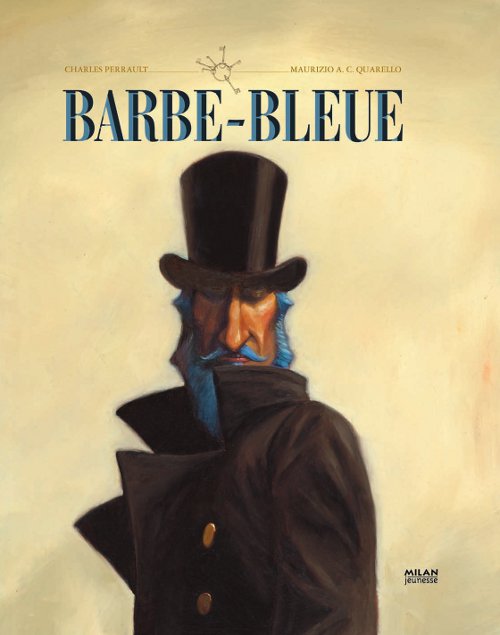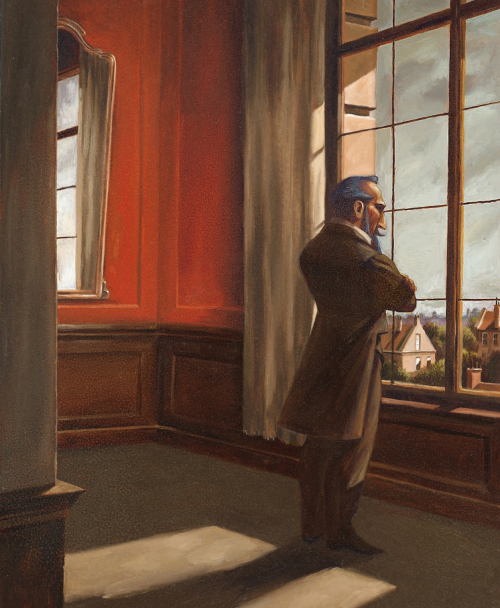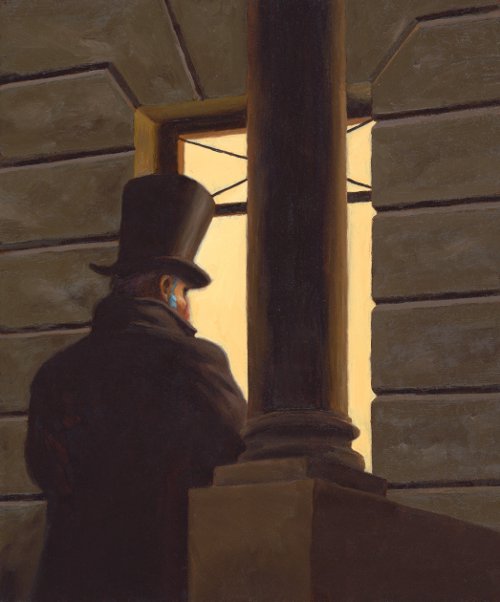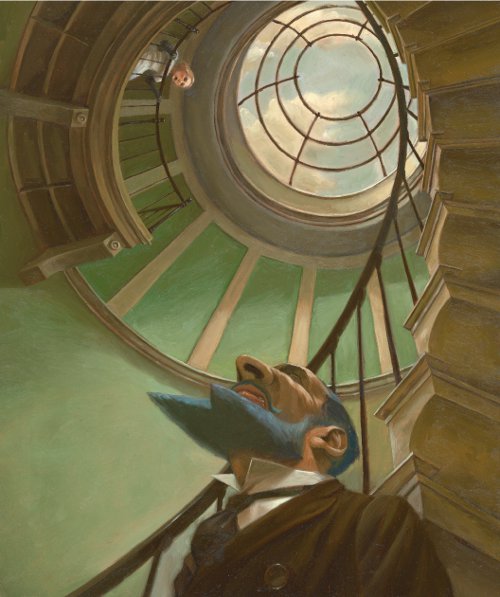Cristiana Clerici's International Spotlight:
Maurizio Quarello's Take on BluebeardJULES: It's time to welcome again Cristiana Clerici for another international picture-book spotlight. And today she treats us all to an Italian illustrator and French book.
As a reminder, these posts are all Cristiana's doing, since I asked her last year to stop by 7-Imp when the mood strikes her to show us what is happening in contemporary picture books over in Europe. In this case, it's one Italian illustrator's take on the demented, bloodthirsty aristocrat Bluebeard of the classic tale by Charles Perrault. In case you missed it earlier, to get the low-down on what I'm calling Cristiana Clerici's International Spotlights, visit this page of the site.
I thank her kindly for contributing. You can click on each image below to super-size it and see in more detail.
Cristiana
Dietro ogni libertà sospirata
c'è in agguato una belva.Alda Merini (1)
In those few lines by the great Italian poet, who died about a year ago, is fully contained the essence of Blue Beard's drama: the moment of pathos lived by his last young wife, imprisoned in a reality that suddenly falls on her with all its weight.
Blue Beard is a well known story: it's the story of a man we would most probably call a serial killer and a woman who, first of all, is the victim of her naïveté, of her thirst for social fulfillment, of her curiosity, and then of the man everybody is afraid of.
What really makes a difference in this picture book, published by the prestigious French publisher Milan Presse, are its illustrations by Maurizio Quarello.
Maurizio is a master illustrator, gifted with incredible explanatory skills and an enviable pictorial technique. In his representations he is extremely versatile. He can give voice to every story with uniqueness, letting the tale lead the way, adapting his technique to narrative needs: we saw him passing from the mellow density of Babau Cerca Casa, Toni Mannaro, and Le Voyage de la Femme Éléphant, to the almost absence of colour of Les Arbres Pleurent Aussi, where his delicate and poetic narration almost tiptoes on the text, to end up with the more comic-oriented setting of Effets Secondaires. just published by Le Rouergue.
In this picture book, Maurizio lets transpire all his love for cinema. If you asked me to give a definition of this book, I shall say it's a cinematographic picture book, where Ivory's romantic atmospheres or those of the last Pride and Prejudice by Wright shine through. It's an artwork where everything is movement; stillness, likewise.
Every image represents a moment seized and crystallized in a frame, going well beyond the page. Every table, even those apparently more silent, tell about a growing pathos that will culminate in the defeat of the terrible Blue Beard.
The narration starts with an emblematic image: Blue Beard looks thoughtfully out of the window, winded up in the light that shines shyly through clouds charged with rain, presentment of imminent disasters. We see him in the act of observing his unaware victim, almost lying in ambush. We can sense her unawareness, her last moments of innocence, she, who still doesn't know what the future will hold for her. We observe them, newly married, on the carriage that will take them into their new lives. Then nothing but the emptiness of a long corridor in the shade, alluding to a dreadful mystery. And then, after a non-defined lapse of time, we can see her friends entering the house, taking advantage of the dreaded husband's absence to finally sneak into a private room that arouses envy and curiosity; we see the young wife opening the forbidden door, victim of her own curiosity, discovering at last the macabre secret hidden behind her husband's blue beard.
The key stained with blood stands alone, clear evidence of the young woman's guilt and only witness of her dreadful discovery, hanging over like a silent exposure of her female weakness in front of prohibition. The husband arrives home in a mantle of obscurity.
From this point on, events succeed rapidly, dramatically so, and the tables give full dynamism to the action: Blue Beard discovers the truth, and he accuses his wife and condemns her to death, like he did with his other wives. Image-narration, which up to this moment had been consecutive and descriptive, now seems to be abruptly changing course by introducing disturbing image pauses that considerably contribute to increased dramatic tension. Perspective-changes, frequent and sudden, give the story a particularly vigorous intensity.
After Blue Beard has pronounced his deathly sentence, the illustrator surprises us once more by transporting the scene out of Blue Beard's apartments, changing completely the atmosphere: in a temporal suspension similar to that of a soaring bird, the bride's sister appears in the act of looking out of the window of her room. Were it not for the text, we would only sense the clear sky and spring-time with its suspended stillness. It's the central image of the narration, the turning point that allows us to breathe and to feel hopeful again, an image that, for that light grace and for the intensity of the moment it describes, reminds me of the poetry of Keats http://en.wikipedia.org/wiki/John_Keats.
But it's just a moment, because we are immediately trapped in a vortex of dreadful events that leads us to the climax of the story.
Quarello uses cinematographic techniques with enviable skill. He masters them with ease, as if his job were film director and not illustrator. From shot and reverse shot, to zoom, to image pause, it seems his illustrations are not meant to stop with the page's boundaries, as if they wanted to drag us into the whirlpool of events. And this is exactly what happens.
His paintings strongly recall Hopper and the Romantics' atmospheres: from the colour palette he chooses, to the polished density of his brush strokes, to his way of playing with lights and shades, to the portrayed subjects. The unexpected framings, always astounding, characterize his images.
Once again, a masterpiece you shouldn't miss.
If you like Maurizio Quarello, stay tuned. More news soon.
* * * * * * *
- Aforismi e Magie by Alda Merini with drawings by Alberto Casiraghi, Rizzoli Publishing, November 1999. "Behind each longed freedom / there's a beast ambush." Alda Merini was a famous Italian poet, notorious for her sarcastic, though romantic, vision of life. She was a singular woman, who lived her life always being true to herself with dignity and wisdom, a most beloved poet.
Barbe Bleue by Charles Perrault, illustrations by Maurizio Quarello, Collection Albums Classiques, (c) 2010 Éditions Milan. Images have been reproduced with the publisher's permission. Any reproduction forbidden.
About Cristiana Clerici
A native of Italy, Cristiana Clerici works full time in press relations for a company based in Parma. As a college student, she studied English and French Literature and Language and Theater History."How did I end up studying and writing about children's literature? I actually never dismissed it to be true: I kept going to the Bologna Children's Book Fair, I kept reading critiques and studying the texts I could find on this topic. Also, at one point I felt I needed something creative, inspiring, and something I really, really loved in order to escape routine and boredom: some end up spending hours at the gym, others taking cooking classes, I picked my favorite sport--reading. A bit more than a year ago I decided to start my blog(s), because I wanted people from all over to know about the books I love, not that they should care much in the end, but this is how it works: another one who talks about things she likes! Yeah!! Well, more seriously: I wanted people from other countries to know books that were not published abroad and vice-versa. I am deeply convinced that literature (and culture in general) is exchange and communication and that only by sharing can we grow. I wished we could return to that intellectual exchange that was so widespread and important right after the two big wars: when you lose freedom and finally recover it, you know how important communicating and sharing with others is. And so I decided to share as much as I could, in the languages I know, with all my imperfections: a small drop in the ocean. I mainly write about picture books, but I love novels as well."
"In the end it all comes back to when I was a kid and my granny took me in her arms and told me wonderful stories: it always ended up with me wide awake and granny totally asleep. Her fantasies, though, were such an incredible gift that keeps nourishing me, even if I'm not a child, or even a teenager, anymore. This is one of the reasons why kidslit is so fascinating to me: I can rediscover something I thought was gone for good."
Founder/Publisher/Editor: David McGee
Contributing Editors: Billy Altman, Laura Fissinger, Christopher Hill, Derk Richardson
Logo Design: John Mendelsohn (www.johnmendelsohn.com)
Website Design: Kieran McGee (www.kieranmcgee.com)
Staff Photographers: Audrey Harrod (Louisville, KY; www.flickr.com/audreyharrod), Alicia Zappier (New York)
E-mail: thebluegrassspecial@gmail.com
Mailing Address: David McGee, 201 W. 85 St.—5B, New York, NY 10024






